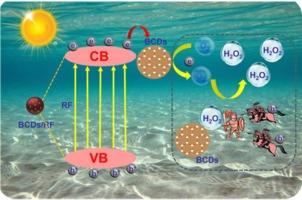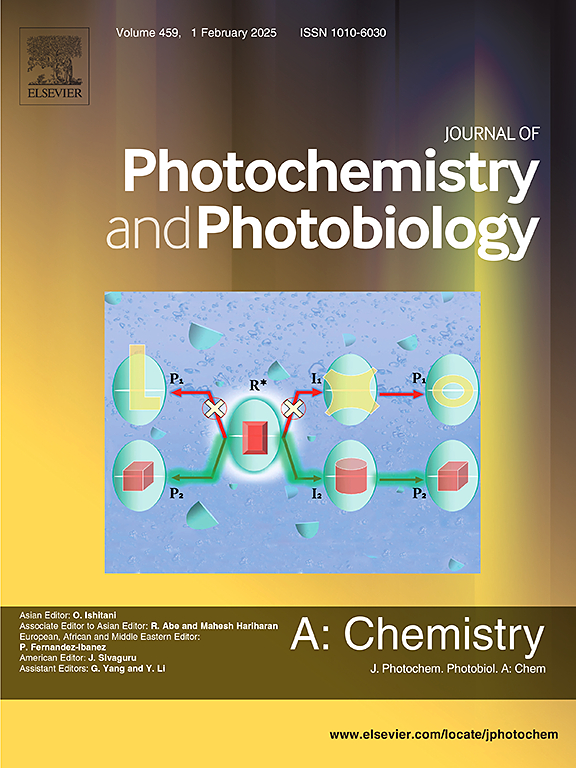生物质碳点装饰间苯二酚-甲醛树脂在纯水中可持续光催化产生 H2O2
IF 4.1
3区 化学
Q2 CHEMISTRY, PHYSICAL
Journal of Photochemistry and Photobiology A-chemistry
Pub Date : 2024-09-29
DOI:10.1016/j.jphotochem.2024.116058
引用次数: 0
摘要
光催化生产过氧化氢(H2O2)是替代传统工业生产方法的一种前景广阔的绿色战略。本文通过一种简单的水热法,成功地将银杏叶衍生的生物质碳点(BCDs)负载在间苯二酚-甲醛(RF)树脂表面,形成了BCDs/RF复合光催化剂,在纯水中实现了高效、可持续的光催化生产H2O2,而无需牺牲剂和气泡O2。BCDs/RF-5 复合催化剂的最佳 H2O2 产率为 1430.31 μmol h-1 g-1,太阳能化学转换(SCC)效率高达 1.1%,是纯 RF(1222.59 μmol h-1 g-1)的 1.16 倍。一系列测试结果表明,BCDs/RF 复合材料中的 BCDs 不仅作为电子受体提高了 RF 树脂的光生电荷分离效率,还有效抑制了 H2O2 的分解,另一方面提高了光催化产生 H2O2 的产率。该研究为射频基光催化剂的设计与合成提供了一种新策略,拓展了生物质材料在光催化产生 H2O2 中的应用。本文章由计算机程序翻译,如有差异,请以英文原文为准。

Sustainable photocatalytic H2O2 production in pure water from biomass carbon dots decorated resorcinol–formaldehyde resin
Photocatalytic production of hydrogen peroxide (H2O2) is a promising green strategy to replace conventional industrial production methods. Herein, ginkgo biloba-derived biomass carbon dots (BCDs) were successfully loaded on the surface of resorcinol–formaldehyde (RF) resin by a simple hydrothermal method to form a BCDs/RF composite photocatalyst, which enabled efficient and sustainable photocatalytic H2O2 production in pure water without the sacrificial agents and bubbling O2. The optimal H2O2 yield of the BCDs/RF-5 composite catalyst was 1430.31 μmol h−1 g−1 with the solar energy chemical conversion (SCC) efficiency was up to 1.1 %, which was 1.16 times higher than that of pure RF (1222.59 μmol h−1 g−1). A series of testing results illustrate that the BCDs in the BCDs/RF composite not only acted as electron acceptors to enhance the photo-generated charge separation efficiency of RF resin, but also effectively inhibited the decomposition of H2O2, and on the other hand improved the yield of photocatalytic H2O2 production. This study provides a new strategy for the design and synthesis of RF-based photocatalysts and expands the application of biomass materials in photocatalytic generation of H2O2.
求助全文
通过发布文献求助,成功后即可免费获取论文全文。
去求助
来源期刊
CiteScore
7.90
自引率
7.00%
发文量
580
审稿时长
48 days
期刊介绍:
JPPA publishes the results of fundamental studies on all aspects of chemical phenomena induced by interactions between light and molecules/matter of all kinds.
All systems capable of being described at the molecular or integrated multimolecular level are appropriate for the journal. This includes all molecular chemical species as well as biomolecular, supramolecular, polymer and other macromolecular systems, as well as solid state photochemistry. In addition, the journal publishes studies of semiconductor and other photoactive organic and inorganic materials, photocatalysis (organic, inorganic, supramolecular and superconductor).
The scope includes condensed and gas phase photochemistry, as well as synchrotron radiation chemistry. A broad range of processes and techniques in photochemistry are covered such as light induced energy, electron and proton transfer; nonlinear photochemical behavior; mechanistic investigation of photochemical reactions and identification of the products of photochemical reactions; quantum yield determinations and measurements of rate constants for primary and secondary photochemical processes; steady-state and time-resolved emission, ultrafast spectroscopic methods, single molecule spectroscopy, time resolved X-ray diffraction, luminescence microscopy, and scattering spectroscopy applied to photochemistry. Papers in emerging and applied areas such as luminescent sensors, electroluminescence, solar energy conversion, atmospheric photochemistry, environmental remediation, and related photocatalytic chemistry are also welcome.

 求助内容:
求助内容: 应助结果提醒方式:
应助结果提醒方式:


